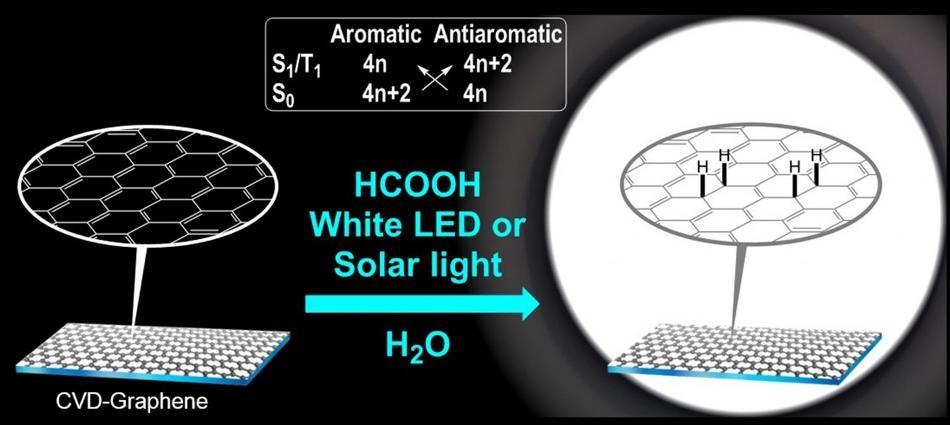Oct 7 2016
 This image shows a new efficient and low-cost method for hydrogenation of graphene with visible light. (CREDIT - Joakim Bergman, AstraZeneca)
This image shows a new efficient and low-cost method for hydrogenation of graphene with visible light. (CREDIT - Joakim Bergman, AstraZeneca)
An efficient, environmentally-friendly, and economical technique for hydrogenation of graphene using visible light has been developed by a team of researchers at Uppsala University and AstraZeneca Gothenburg, Sweden. The research findings have been published in Nature Communications.
The research revealed that the 2D and atom-thin carbon material graphene reacted when exposed to formic acid in a water solution upon irradiation using visible light. In the reaction, the formic acid serves as masked hydrogen and a material is generated where hydrogen was added to graphene in large amounts. It can be said that graphene was hydrogenated.
The research was conducted by Assoc. Prof. Henrik Ottosson's research team at the Department of Chemistry - Ångström Laboratory, along with colleagues in Chemistry, Physics and Engineering at Uppsala University and at AstraZeneca Gothenburg.
The reaction is convenient and cheap, and hydrogenated graphene may be applied within areas such as hydrogen storage. Additionally, upon functionalization of graphene one can open a band gap and this fact is of high relevance for electronics applications.
Henrik Ottosson, Associate Professor, Uppsala University
Graphene research remains a side-project in Henrik Ottosson's team. The team normally studies the characteristics of several aromatic hydrocarbons upon irradiation, and they make use of the Baird's rule, which can be derived using chemically applied quantum mechanics.
Chemical compounds with aromatic characteristic have a naturally high stability and cannot be easily degraded. Benzene is the most well-established aromatic compound and over half of all documented chemical compounds possess aromatic groups.
The high stability of aromatic compounds is illustrated by Hückel´s "4n+2" rule, however this rule is only applicable for compounds in their electronic ground states. When exposed to light of a specific wavelength, the aromatic compounds achieve electronically excited states.
According to Baird, compounds that are aromatic in the ground state turn reactive and anti-aromatic in the excited state. The rule, ignored for years, can now be used to explain a variety of behaviors of aromatic compounds when irradiated. Henrik Ottosson's team prepares new light-initiated reactions using Baird's rule. First, they analyzed addition of hydrosilanes to benzenes, naphthalene and steadily larger polycyclic aromatic hydrocarbons.
Although the fact remains that it is not possible to clarify if, and how, Baird's rule can be applied to graphene (a infinitely large polycyclic aromatic hydrocarbon), the team investigated graphene chemistry and discovered a highly efficient addition reaction when using formic acid.
At AstraZeneca, exciting possibilities for the future can be clearly seen:
It has become more common to apply light-initiated reactions during the development of new molecules in our drug research programs. We challenge ourselves to continuously develop more efficient and environmentally friendly chemical methods. The recent progress we have seen in photochemistry, highlighted by the results herein, will increase our opportunities to access chemistry that no one thought possible a few years ago. In addition, graphene based materials have exceptional inherent properties. There is a wealth of possible applications that could result in the next biomedical revolution.
Joakim Bergman, Innovative Medicines and Early Development Biotech Unit, AstraZeneca Gothenburg.